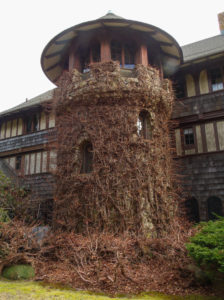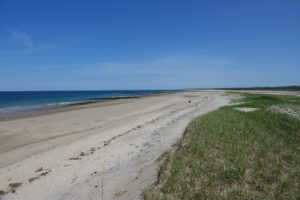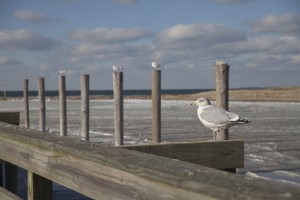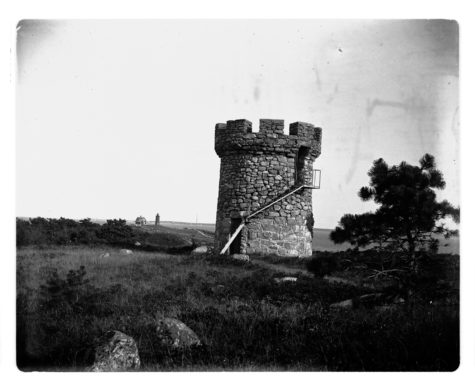
Glidden Tower as it appeared in 1894. Photo courtesy of History Archives of the Marine Biological Laboratory.
Cape Cod is filled with beautiful historic spots, places where one can visit and get a glimpse of the way things used to be without leaving the present time. Homes from the 17th and 18th century dot the landscape, connecting today with yesterday.
The Cape also has its share of historic places which have been lost to the ages either by nature reclaiming its hold, accident, or simply making way for the future. Billingsgate Island in Wellfleet and the original brick Three Sisters Lighthouses in Eastham are shining examples of lost history.
There is one historic spot though that falls into both of these categories. It is still standing yet cannot be seen or visited, unless perhaps with special permission.
Sitting on a hill overlooking Nobska Pond and Vineyard Sound in Woods Hole sits Glidden Tower. It is named for the man who owned it as well as the surrounding property, John M. Glidden. The stone tower was built along with a home in 1879. The tower was possibly used to store water, or as a signal tower used to announce the arrival of large ships. The panoramic view was magnificent as there was limited tree cover to obscure the surroundings.
Glidden was a well known businessman in Woods Hole. He became treasurer of the Pacific Guano Company which was a fertilizer business located on Long Neck, the western peninsula of the village, known today as Penzance Point. The company was begun in 1859 with the help of the U.S. Guano Act of the same year. This stated that any uninhabited guano island could be claimed by the United States. The U.S. claimed Howland Island located more than 1,800-miles southwest of Hawaii and mined it out within a few years. A plant was built at Long Neck in 1863 with a second plant being built in Charleston, South Carolina in 1869.
The Pacific Guano Company more than doubled the population of Woods Hole in thirty years. The story though does not have a happy ending. In 1889 the company’s finances were in ruin and history has laid the blame on John Glidden. Pacific Guano Co. declared bankruptcy and the plant was abandoned. Shortly thereafter Glidden left Woods Hole and his estate behind, never to return.
His home and the tower would not be lived in again but would see its share of visitors. The home would then be removed leaving only the tower behind. From 1889-1921 countless people came to visit the tower. People would take photographs around it and inside it, there would be marriage proposals made at it, and it also became a rendezvous point for local lovers. Glidden Tower maintained its fame long after John Glidden had left the Cape for the last time.
In 1921 Newcomb Carlton, then-president of Western Union Telegraph Company, bought five-acres of the property from Glidden including the portion which contained the tower. He would commission well-known architect William Welles Bosworth to build a custom three-story house on the hill. Bosworth would become known for designing parts of the Rockefeller Estate in Tarrytown, New York. Rather than remove the stone tower Bosworth incorporated the tower into the home, replacing the outer stairway with an indoor spiral staircase and putting a conical roof on top of it. It would be used as an entrance way.
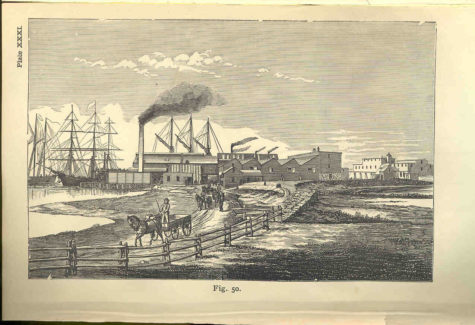
The Pacific Guano Company of Woods Hole circa 1877. Photo courtesy of Freshwater and Marine Image Bank.
The home was finished in 1927 has been passed down through the Carlton family and is currently owned by Rhona Carlton-Foss. She is the granddaughter of Newcomb Carlton, a retired math teacher from the Cambridge School of Weston and a member of the Falmouth Commission on Disabilities. Although the home and property are private she was kind enough to allow a current photo of the tower to be taken. A special thank you to her.
Trees may obscure the once-pristine view of Nobska Light and Vineyard Sound, also keeping the home virtually hidden from sight, yet there is something magical about the stone tower. Now part of the Carlton home for nearly a century, and wrapped snugly with vines, the former Glidden Tower is nearly unrecognizable upon first glance. However one only needs to close their eyes in its presence to imagine standing on top of it a century ago staring out at the majesty of Cape Cod in a much simpler time.
By Christopher Setterlund




